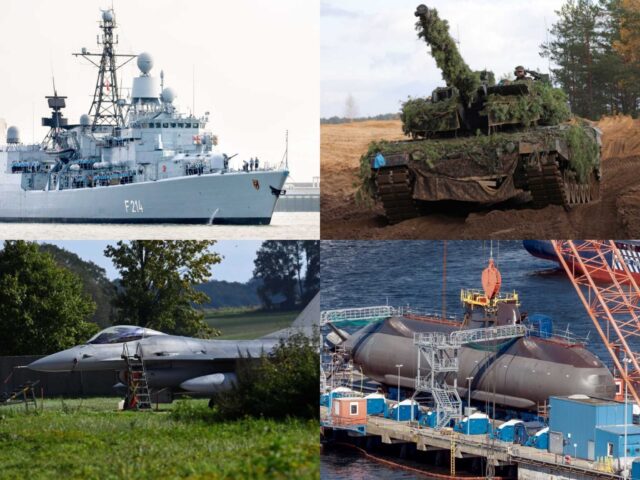Western countries agreed to supply tanks for use against the Russian invasion this week, prompting the Ukrainian government to push the envelope further, with discussions about more major military equipment advancing.
(above, clockwise from top left: German Frigate Lübeck (F214), German Leopard-2 Main Battle Tank, German 212A diesel-electric hydrogen fuel cell attack submarine, F-16 fighter jet)
Talk of NATO nations supplying long-range missiles, warships, submarines, and fighter jets is evident, with Ukrainian government figures seemingly tasked with acquiring new equipment wasting absolutely no time to push new ideas immediately after the dam burst on tank supply.
The shift from tank talk to fighter jets was, perhaps inevitably, almost instantaneous after the United States and Germany dropped their previous objections to sending offensive armour to Ukraine this week. Yet the conversation has, at the hands of Ukrainian politicians and diplomats trying to talk Western powers into sending more equipment, taken another leap forward.
Discussions to get long-range missiles to Ukraine are apparently well underway, with reports describing the talks as “fast-track”. Advisor to Ukrainian President Zelensky, Mykhailo Podolyak, who has been a cheerleader for western warplanes is involved in the missile talks and said he was trying to explain to allies that getting the advanced weaponry would “reduce fatalities… reduce security threats to the European continent, this will keep the war localised”.
Now Send Fighter Jets: Ukraine Wants Air Superiority After Securing Battle Tanks https://t.co/07tZN4My6m
— Breitbart London (@BreitbartLondon) January 26, 2023
Nevertheless, Podolyak criticised some unnamed allied nations as being “conservative” in their attitude in sending military aid because they feared “changes in the international architecture”, in other words, deviance from the status quo.
But even larger and more sophisticated weapons than long-range missiles, main battle tanks, and jet fighters are apparently on Ukraine’s shopping list. Deputy Foreign Minister Andrij Melnyk, who hit the headlines this week for instantly demanding jets even as the ink on the tank deal was still drying, has been turning his attention to naval power.
Speaking of Ukraine’s ambition to kick Russia out of the black sea, the diplomat pointed to Germany’s class of six 212A diesel-electric attack submarines, asking for one of them, and a German frigate, the Lübeck which was taken out of service last month.
The 212A submarines are regarded as small and stealthy craft, using hydrogen fuel cells powering an electric motor for silent running underwater. “Why not to send one to Ukraine?”, Melnyk posited.
‘Total Madness’ – Admit Ukraine into NATO and Give Them More Guns, Boris Johnson Demandshttps://t.co/6MrVdSfOBu
— Breitbart London (@BreitbartLondon) January 24, 2023
The diplomat, who is the former Ukrainian ambassador to Germany, put forth a similar argument for a German warship. Laid down in the 1980s and decommissioned in December after it completed its final deployment last summer, the frigate Lübeck is therefore presently surplus to requirement but may still be in a position to be re-activated quickly.
Melnyk said of the ship that with political will “it could be transferred to Ukraine to combat [Russian] submarines & war ships in the Black Sea”, citing the ship’s Sea Sparrow and Harpoon missiles.
The requests for ever more sophisticated weapons of war beg serious questions for Western allies about how involved, exactly, they are willing to get in Russia’s war against Ukraine.
The United States had long insisted — right up until the point it flipped and agreed to send them — that its Abrams main battle tanks were too sophisticated to quickly train Ukrainians to drive, fight, and maintain. Yet donating a submarine with a novel energy system without crew is a whole new level of complexity. Sending a manned submarine is immediately possibly, but of course would be an actual act of war by a NATO member.
A typical submarine crew would embody decades of experience and training to effectively use one of the most sophisticated weapons systems in the world, and even for experienced crews in competent navies the complexity of submarine operations has meant a steady drumbeat of subs grounded, damaged, and lost — with deadly consequences — for as long as they’ve been in service.
Underlining the problem, German state politician Martin Habersaat quipped back at Melnyk’s request for one of Germany’s six submarines, asking how many sailors in Ukraine’s navy knew how to operate submarines at all.
Putin Now in a ‘War Against NATO and the West’ in Ukraine, Claims EU Official https://t.co/UpCDAQ8r6y
— Breitbart London (@BreitbartLondon) January 28, 2023

COMMENTS
Please let us know if you're having issues with commenting.